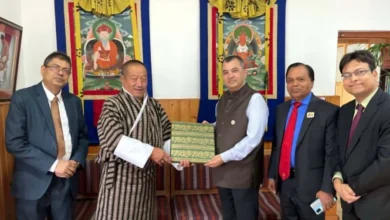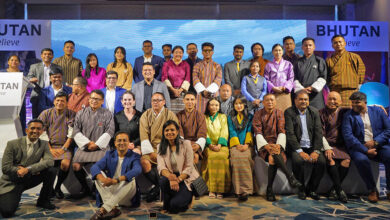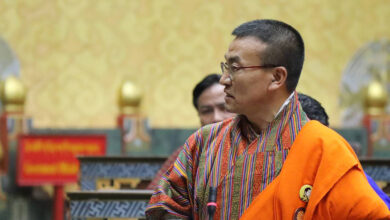Bhutan’s economy should focus on economic efficiency: UN DESA Chief
Hamid Rashid delivered a talk on global economy outlook and implications for Bhutan at the Royal Institute for Governance and Strategic Studies Friday forum in Thimphu on May 19.

Thukten Zangpo: For long-term economic growth, Bhutan’s economy should focus on efficiency gains, the Chief of Global Economic Monitoring, United Nations Department of Economic and Social Affairs (UN DESA), Hamid Rashid (PhD) said.
Hamid Rashid delivered a talk on global economy outlook and implications for Bhutan at the Royal Institute for Governance and Strategic Studies Friday forum in Thimphu on May 19.
Hamid Rashid said that Bhutan’s economy grew at an average of 6 percent annually between 1990 and 2020, outperforming the comparable economies where Nepal grew at an average of 4.4 percent and South Asia at 5 percent.
However, the economic growth rate is projected to slow down to 1.9 percent between 2020-25 and 3.3 percent between 2025-2030, he added. The economic growth is projected at 4.5 percent this year and 4 percent in 2024.
“For a large economy, this growth is impressive, however, for a small economy like Bhutan, it is worrisome. Bhutan’s economy could have grown much higher between 7 percent to 10 percent.”
Similarly, the global economy is expected to grow by 3.1 percent during 2001-2020, Hamid Rashid said. “Global growth will likely average 2 percent during the next decade.”
Given the vulnerability of Bhutan’s economy to global external shocks as evident from the pandemic where the economy shrank by -10 percent, he said that it would mean less tourism revenue for Bhutan because advanced economies will have lesser money to spend.

This would lead Bhutan’s GDP to decelerate in the coming years given Bhutan’s narrow economic base, being largely dependent on hydropower and tourism, Hamid Rashid said.
He said that the monetary tightening in developed economies to tame high inflation will create limited fiscal space, less money available for discretionary spending.
“This challenging environment means lesser official development assistance and foreign direct investment for Bhutan because the money will be now redirected from the donors in rebuilding Ukraine,” Hamid Rashid said.
He also said that developed economies are facing trilemma–taming inflation, ensuring financial stability and stimulating economic growth. These three objectives cannot be achieved together.
Hamid Rashid said that another challenge for Bhutan is high rural-urban inequality. He said that average per capita income in urban areas of Bhutan at USD 8,000 in nominal dollar terms is 10 times higher than the rural areas of about USD 900 per capita. “This will have a significant effect on rural-urban migration.”
With an aging population, he said a slow population growth rate compared to developed countries, Bhutan will age first before becoming rich unlike other economies where they become rich first and age later. “More elderly population will affect the total output.”
Going by the projections, if Bhutan’s economy grows at 7 percent growth rate, it would take 10 years to double its GDP. If it grows by 10 percent, it would take seven years to double, and if it grows by 15 percent, it would double in 5 years.
However, at 3.3 percent yearly growth rate, it would double in about 23 years. On the other hand, Bhutan aims to double its GDP from USD 2.5B (billion) to USD 5B by 2029 and USD 10B by 2034.
Hamid Rashid said that Bhutan has huge potential to recalibrate its growth model and achieve a much faster growth rate and there is opportunity to strategise.
He said that there has been a huge disparity between the gross-value added by persons employed and sectors’ share of employment.

“Roughly about 4,000 people are employed in the hydro and water related sector, however, it produced about USD 300 million GDP. While, about 50 percent of the labour force employed in the agriculture sector produced a similar amount of GDP,”
Hamid Rashid said, adding that there is huge scope for rapid improvement in an agricultural sector.”
Hamid Rashid said that the long-term economic growth comes from the total factor productivity (TFP)-how capital and labour productivity combined together give value addition.
He said that Bhutan’s GDP growth since the 1990s grew by 5.7 percent on average, where nearly two-third of the GDP growth came from capital accumulation which is declining.
This means adding capital in building hydro projects and infrastructures in the economy. This has led to increasing labour productivity and declining marginal productivity.
Hamid Rashid said that Bhutan’s labour productivity growth contributed to 9 percent of the GDP, similar to India’s contribution at 3.4 percent growth rate annually in the last 50 years.
However, he said that TFP contributed only 6 percent of the growth for Bhutan, while 25 percent for India. “Low TFP indicates economic inefficiency.




